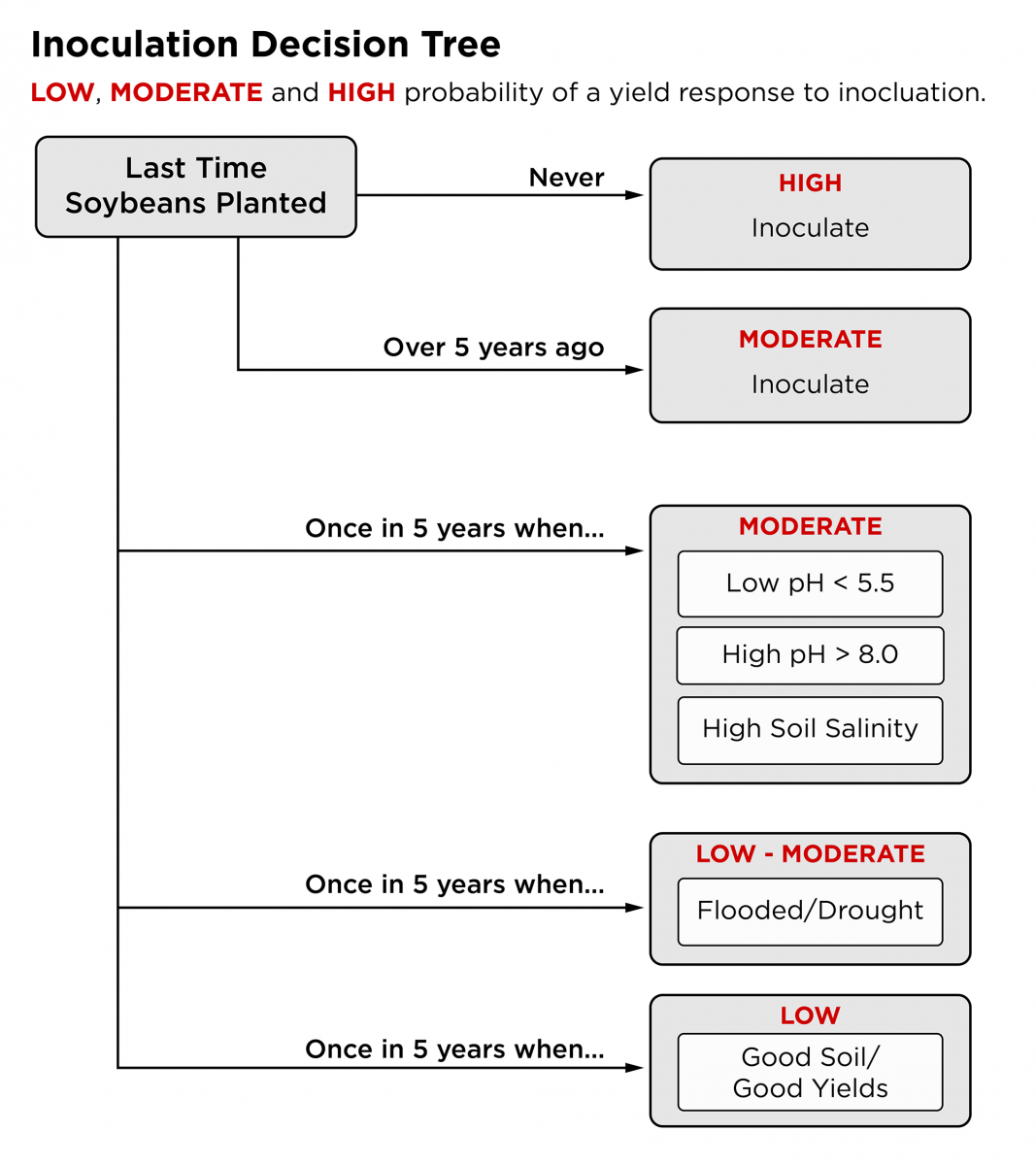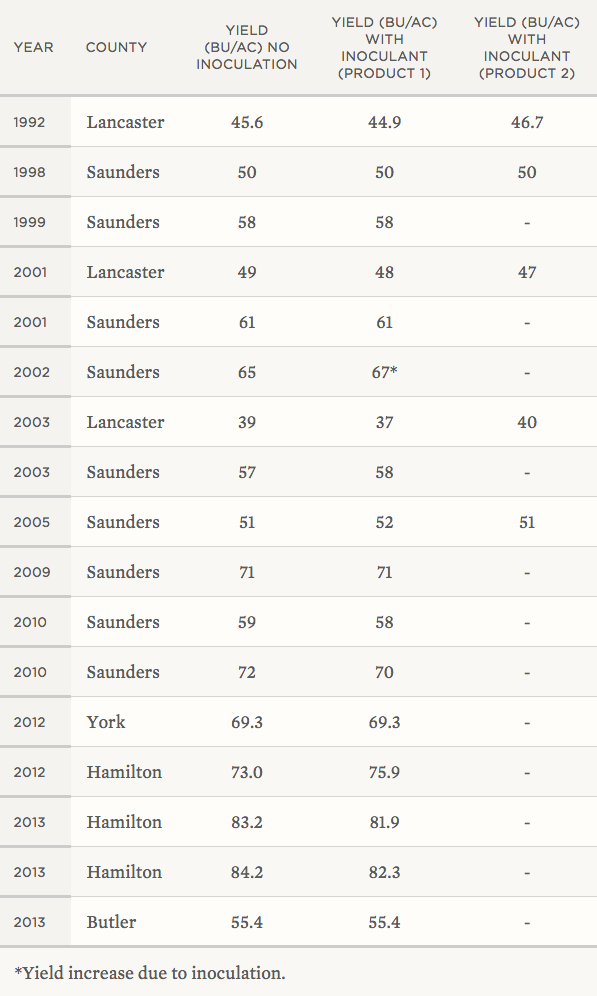By Nathan Mueller, Extension Educator; Roger Elmore, Extension Cropping Systems Agronomist; Charles Shapiro, Extension Soil Scientist—Crop Nutrition; Jenny Rees, Extension Educator; Laura Thompson, Extension Educator
Nebraska farmers must scrutinize inputs and focus on finding profit for their estimated 5.7 million soybean acres in 2017. Among the many springtime decisions farmers make is whether to inoculate their soybeans. Based on information from farmers, agronomists and researchers, follow these steps when deciding whether to inoculate soybeans:
- Understand soybean nitrogen (N) needs and the product label
- Place each of your fields into one of the following four categories to estimate probability of a yield response
- Use data to guide your decision
Nitrogen Fixation from Bacteria is Important
The process of fixing N in the soil air to ammonia occurs through the symbiotic relationship between soybeans and the Bradyrhizobium species, a bacteria within the nodules of soybean roots. Soybeans get needed N and the bacteria get some carbohydrates in return.
This process provides soybean plants 46%-74% of the N they need; the remaining amount is taken up from the soil. A 70-bushel-per-acre soybean crop takes up roughly 330 pounds N per acre in the aboveground portion of the plant, roughly equivalent to the N demand of a 245-bushel-per-acre corn crop. Many products state they’ll provide increased microbial activity, microbial health, and plant health. Make sure your inoculation product contains Bradyrhizobium japonicum cells.
Estimating Probability of a Yield Response
Place each of your fields into Category 1, 2, 3 or 4 described below.
Field Category 1: No previous history of soybeans and inoculation
Probability of a Yield Response: High
 In situations where soybeans have never been grown, yield increases of as much as 49 bushels per acre were measured in Nebraska fields with the addition of inoculant. However, more modest yield increases of 1-10 bushels per acre are expected. Yield effects are largely dependent on the N supply from soils and the relative increase in N fixation.
In situations where soybeans have never been grown, yield increases of as much as 49 bushels per acre were measured in Nebraska fields with the addition of inoculant. However, more modest yield increases of 1-10 bushels per acre are expected. Yield effects are largely dependent on the N supply from soils and the relative increase in N fixation.
Field Category 2: More than 5 years since soybeans were last planted
Probability of a Yield Response: Moderate
The three most common situations in Nebraska where soybeans may benefit from inoculation are when they are planted
- after 5 or more years of continuous corn
- after alfalfa
- in land coming out of CRP
Most university guidelines suggest inoculating if it has been more than 5 years since soybeans were last grown in the field. An inoculation study was imposed from 2009-11 within a long-term (initiated in 1983) crop rotation and tillage study in Wisconsin. Researchers in this study measured a 2-bushel-per-acre yield increase with inoculation (Optimize) after 5 years of continuous corn production when averaged across tillage/crop rotations.
A 2009 Iowa study reported inoculation increased soybean yield 2 bushels per acre on land coming out of pasture that had not been cropped for at least 20 years. Also, in a long-term study in Saunders County, Nebraska, no yield response to inoculation was measured even after 28 years of continuous grain sorghum production.
Field Category 3: Soybeans have been in rotation once in every 5 years, but there have been poor soil conditions for bacteria survival
Probability of a Yield Response: Moderate to Low
Several environmental factors can cause poor nodulation, decrease N fixation and reduce survival of these bacteria.
- Non-Optimal Soil pH. Low soil pH can decrease nodulation, N fixation and survival of various strains. Ideal pH is near 6.8. Soil pH less than 6.0 can decrease root hair modification needed for the formation of nodules. Therefore, following economic thresholds for lime application when soil pH decreases to 5.6-5.8 also manages soil bacteria. High soil pH (>8.0) can also decrease nodulation, N fixation and survival of these bacteria.
- High Soil Salinity. High soil EC (unknown threshold) can also decrease nodulation, N fixation, and survival of these bacteria.
- Floods, Droughts, and Soil Texture. Fields flooded for more than 1 week decrease N fixation and can decrease survival of bacteria because bacteria need oxygen. However, two recent research studies suggest not being overly confident in assuming a yield response to inoculants after floods. On the other end of the soil moisture scale, research shows that 4- and 8-week droughts decrease Bradyrhizobium japonicum populations on both silt loam and sand soils (sand soils were more negatively impacted); however, decreases in B. japonicum were not large and the researchers suggested that growers likely would not need to inoculate the soil after a drought like 2012.
Field Category 4: Soybean in rotation once in every 5 years with good soil conditions for bacteria survival
Probability of a Yield Response: Low
The probability of a yield response in fields with a recent history of soybeans is extremely low unless the field is affected by the environmental factors in Field Category 3. An 8-year study testing 51 inoculant products in 73 experiments conducted in Wisconsin, Iowa, Indiana, Minnesota and Nebraska resulted in average yield response of 0 bushels per acre.
Some still advocate for inoculating with more effective N-fixing strains of these bacteria over common indigenous strains, e.g., Bradyrhizobium japonicum Bj123, in the Midwest even when environmental conditions have been conducive for N fixation. In the 2000-08 study, new inoculant products and strains were used. Of the 10 most widely tested products, yields were not influenced in fields with a recent history of soybeans. This is likely due to highly competitive indigenous strains diminishing potential gains from applying more effective strains.
Nebraska Farmers Making Their Own Data-Driven Decisions
Nebraska farmers have conducted their own studies on the need to inoculate soybeans through the Nebraska On-Farm Research Network from 1992 through 2016 (Table 1). Using the new searchable database at resultsfinder.unl.edu, you can review the data for yourself by selecting Crop = Soybeans and Sub Topic = [Crop Management – Inoculant]. Only one of the 17 on-farm studies resulted in a yield increase attributed to soybean inoculation (bolded in Table 1). Also, the cost of inoculant products varied ($0.44-$4.00 per acre) within these on-farm research studies. View specific treatment costs at resultsfinder.unl.edu.
 Table 1. Summary of Nebraska on-farm research on soybean inoculation (1992-2016). View full details at resultsfinder.unl.edu
Table 1. Summary of Nebraska on-farm research on soybean inoculation (1992-2016). View full details at resultsfinder.unl.edu
Summary
If you have managed soil pH well, planted soybeans recently, have medium to heavy textured soils, and have not experienced extended droughts or floods, direct your money away ($2-$4 per acre) from inoculating soybeans and move it to other management options that have an improved chance of return.
Additional Resources
For more information on soybean inoculation, read these Nebraska Extension NebGuides:
- Soybean Inoculation: Understanding the Soil and Plant Mechanisms Involved (NebGuide 1621)
- Soybean Inoculation: Applying the Facts to Your Fields (NebGuide 1622)






Post a comment
Report Abusive Comment